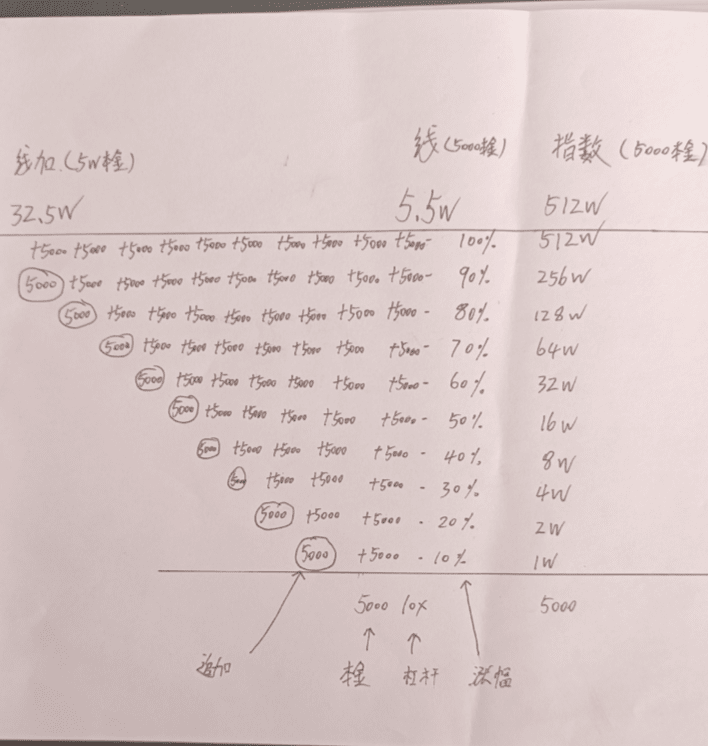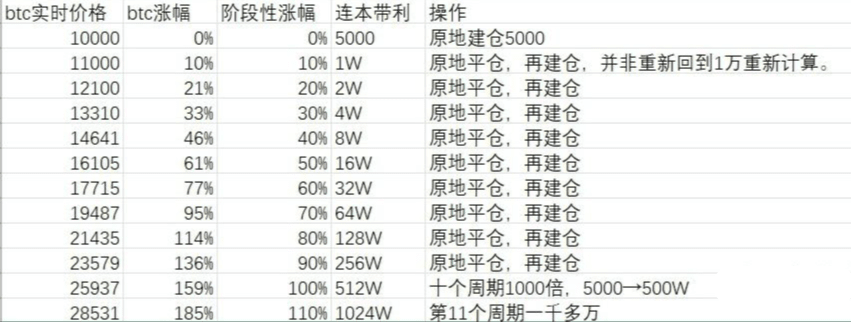Rolling positions are high-yield operations, but they also carry extremely high risks; one must be cautious. The combination of rolling positions (exponential growth) and compound interest model is the high-cost performance strategy.
Note that rolling positions represent exponential growth, while compound interest is a special manifestation of exponential growth. In other words, all compound interest is exponential growth, but not all exponential growth is compound interest. Spot trading is more like a compound interest model, while futures trading resembles a linear growth model. In summary, effective utilization (unrealized profits) is the core of both rolling positions and compound interest!
Floating profit and increased positions are not the same as rolling positions. Because the definitions and methods of rolling positions in the market are all directly copied from the opinions of Fatty, Bitcoin King, and Tony, which are not easy to understand for novices with little investment experience. This article aims to explain in a simple and straightforward manner.
Assume the current BTC price is 10000, opening a position of 5000 with 10x leverage. At this time, BTC rises to 11000, an increase of 10%, and you profit 5000. The next operation is very important.
1. The practice of floating profit and increasing positions is to add another 5000. Then BTC rises to 12000, increasing by 10%. At this point, your total amount (including principal and profit) is 25,000. (Principal of two 5000 + profit of three 5000)
2. The practice of rolling positions is to close the previous position, totaling 10,000 including principal and profit, then open a new position. Subsequently, BTC rises to 12000, with the same 10% increase, at this point, your total amount including principal and profit is 20,000.
Looking at it this way, isn't it indistinguishable? But as long as you keep cycling operations, when BTC rises to 20000, the increase is 100%. The final amount including principal and profit from floating profit and increased positions is 325,000 (including 50,000 principal). The rolling position's total amount including principal and profit is 5.12 million (including 5,000 principal).

Why is there such a big difference? Let's analyze it together.
What is a complete position opening cycle?
Open position → Floating profit → Floating profit → Close position
What is a complete floating profit and increased position cycle?
Open position → Floating profit → Increase position → Floating profit → Close position
What is a complete rolling position cycle?
Open position → Floating profit → Close position and reopen → Floating profit → Close position
OK, here are two more concepts, also explained in a simple and understandable way. One is linear growth, which increases by 10%, 10%, 10%. The other is exponential growth, which increases by 10%, 20%, 40%, 80%. Linear growth is like driving a car with smooth acceleration from 10 to 20 to 80. Exponential growth, on the other hand, is like technological development, which grows exponentially; it starts slowly but accelerates as time goes on. Here's a rough example for understanding: based on certain evidence, it can be proven that humans thoroughly mastered fire 400,000 years ago, electricity 200 years ago, cars about 100 years ago, the internet 55 years ago, and mobile internet 30 years ago. This means that after mastering electricity, human technology developed rapidly. Comparing it to the previous 400,000 years seems trivial. Getting back on track.
Let's make a comparison here:
Ordinary position opening is linear growth; strictly speaking, contracts do not count as linear, but let's use this analogy for easier understanding.
Floating profit and increased positions are the basis for linear growth.
Rolling positions represent exponential growth.
Below is a manually calculated diagram for a more intuitive view. Each of the circled 5000 represents the additional principal from floating profit and increased positions.
Taking all ten times leverage as an example

I. Preparation details
- Asset selection: Choose cryptocurrencies with high liquidity and active short-term volatility (such as mainstream coins or popular altcoins) to avoid excessive slippage due to insufficient trading depth.
- Leverage setting: Choose based on your risk tolerance. Newcomers are advised to start from lower multiples (such as 2-5 times), and experienced traders should also keep it within 20 times to avoid the risk of instant liquidation due to high leverage (over 50 times).
- Time cycle selection: Focus on short-cycle K-lines (such as 1 minute, 5 minutes, 15 minutes) to match the rhythm of high-frequency trading, while also referring to hourly lines and slightly longer cycles to judge the major direction, avoiding counter-trend operations.
II. Trading execution details
- Timing for opening positions: Combine technical indicators (such as short-term moving average crossovers, MACD golden/death crosses, RSI overbought/oversold) to capture entry signals. For example: open a long position when a 15-minute K-line shows a bottom divergence and RSI is below 30, and open a short position when there is a top divergence and RSI is above 70.
- Holding duration: A single position usually does not exceed a few hours, or even minutes, based on the principle of 'take profit when it's good'. Close the position once the profit reaches expectations (such as 1%-3%) to avoid greed.
- Capital rolling: Immediately reinvest the principal + profit into the next trade after closing, keeping the funds continuously operating, but reserve 10%-20% as a backup to cope with sudden market fluctuations or stop losses.
III. Risk control details
- Stop loss and take profit settings: Every order must have a forced stop loss (such as automatic closure at a 2% loss), and take profit can be staged (such as taking half profit at 1% gain and letting the remainder follow the trend), eliminating hesitation in manual closing.
- Position management: The investment in a single trade should not exceed 10%-15% of total funds to avoid heavy positions in a single direction, preventing excessive losses when the market reverses.
- Emotion management: Pause operations during consecutive profits or losses to avoid disrupting the rhythm due to greed (increasing leverage) or impatience (frequently opening positions). Set a maximum daily loss limit (such as 5% of total funds) and stop trading if reached.
IV. Practical considerations
- Avoid extreme market conditions (such as major positive/negative news releases); the volatility is severe at this time, the slippage risk is high, and it is easy to trigger stop losses.
- Prioritize trading platforms with good depth to ensure that buy and sell orders can be executed quickly, reducing losses due to delays.
- Newcomers are advised to practice with a demo account first, get familiar with the rhythm of high-frequency trading, and then move to real trading to avoid bearing high risks directly.
In summary, the core of rolling position operations is 'high-frequency turnover + strict risk control'. Each step must revolve around 'quick profits and controlling losses', requiring very high discipline and market sensitivity; be very cautious when trying.
If you feel helpless, confused in trading, and want to learn more about cryptocurrencies and cutting-edge information, click on my avatar to follow me, and you'll no longer be lost!

